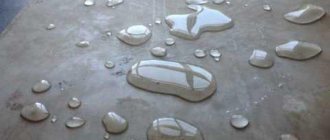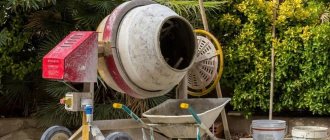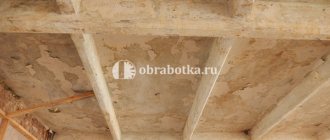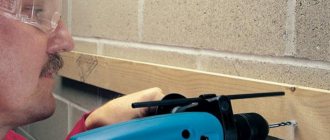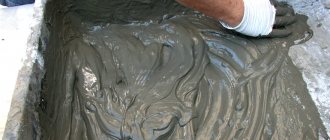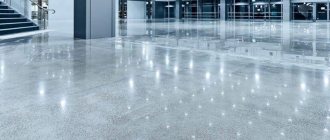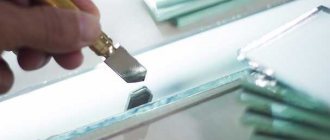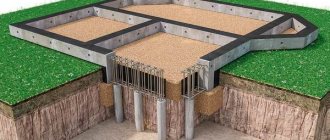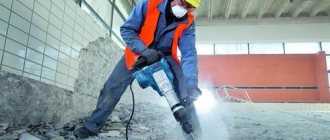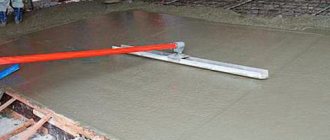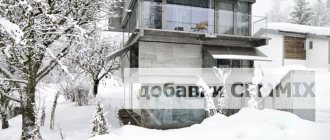SHARE ON SOCIAL NETWORKS
FacebookTwitterOkGoogle+PinterestVk
Concrete is the leading material used in the creation of various projects. Despite the fact that the building material is strong and durable, there are still negative factors that reduce the load-bearing capacity. This includes changes in humidity and temperature, exposure to ultraviolet radiation, shock and vibration loads. Ironing of concrete is a process that can prevent premature destruction of a structure by improving its qualities.
The ironing process extends the life of concrete and prevents deterioration
Why is it needed and what is the technology of ironing concrete surfaces?
During operation, hardened concrete is constantly exposed to various kinds of dynamic and mechanical loads. The ability to withstand negative factors will depend on the initial consistency of the concrete solution and its density. In order to improve the characteristics of the mixture, it is first recommended to carry out the following measures:
Ironing allows you to increase the positive characteristics of concrete
- use sand of different fractions;
- correctly select the optimal ratio of cement, water, plasticizers and fillers.
No matter how well the concrete is laid, there are still pores or microcracks that become gateways for moisture penetration. This is especially dangerous in a situation where there is a constant temperature difference (from plus to minus and vice versa). The smallest ice crystals that form inside the voids can expand them even in a short period, which will lead to the fact that the concrete will quickly begin to lose strength and collapse.
In addition, moisture that penetrates inside can also negatively affect the reinforcing elements located inside reinforced concrete structures. Chemically active elements that can penetrate into the structure along with precipitation also have a negative effect on concrete.
Important information! Despite the fact that concrete is considered one of the most durable building materials, it still has a certain shelf life. Considering that it is reinforced concrete structures that have the strongest and most critical impact, you need to be prepared for the fact that without additional measures, the surfaces may begin to crumble.
Ironing must be carried out at the construction stage or during repair work
A proven and effective option for combating such phenomena is considered to be closing cracks and small pores by ironing the surface. The procedure is performed at the construction stage of the building and during internal finishing activities. Ironing itself is a technological process aimed at increasing the strength of monolithic structures by applying special compounds to the surface that have high adhesion to the top layers.
When is ironing performed?
To ensure the strength of concrete structures, measures to strengthen them are carried out already during the pouring process. For example, sand of different fractions is added to the solution, the amount of cement is increased, and special fillers are added.
However, with regular exposure to moisture, its freezing and thawing, the pores of the top layer begin to expand. As a result, concrete becomes brittle, brittle, and breaks. Chemicals that penetrate with water destroy it even faster.
Ironing screeds
Ironing allows you to seal the surface of cement coatings, clog micropores, which will prevent moisture from penetrating inside and having its destructive effect. External protection of the concrete surface contributes to:
- increasing the tolerance of mechanical loads;
- reducing the risk of destruction from chemical agents, wind, snow, rain, and other atmospheric factors;
- protection against temperature changes that cause freezing and thawing of moisture;
- leveling the surface of the product;
- increasing impact strength and wear resistance.
After ironing the blind area, screed or other concrete structures, the base will not be subject to delamination and cracking. It will last an order of magnitude longer without additional repairs.
Important! It must be remembered that ironing does not affect the quality of the monolith itself. The technology is truly effective if its quality was initially high.
Where is ironing of cement coatings used and what materials are needed for it?
The procedure is also relevant when performing interior finishing work, because even the process of applying plaster is accompanied by the penetration of moisture into microvoids, which leads to the destruction of monolithic parts. When there is a mechanical impact on the surface of the floor in the room, cracks appear, which over time lead to the process of crumbling, which can be combated by ironing the floor screed with cement. It is important to treat with a special compound immediately after filling, because this is how you can maximize the service life.
During construction, the blind area is ironed, which makes the foundation stronger and delays repairs. In fact, the main goal of the process is to increase the strength of the monolith, for which various components are used, including:
- dry mixes based on high grade cement;
- liquid or colloidal solutions with the addition of additives - most often liquid glass;
- materials with a high content of special polymers.
The ironing process is suitable for both interior and exterior work.
Interesting fact! Contrary to the name, in the process of ironing a concrete screed, neither iron nor other materials containing this element are used. The name only indicates the fact that surface hardening occurs, which is compared with the positive characteristics of iron.
The advantage is that you can do the work yourself, you just need to follow the technology and all the requirements of the manufacturer of the composition. Even the slightest non-compliance with the rules will lead to a violation of the composition, and the concrete will not meet the necessary requirements. If we talk about the process as a whole, then it is assigned the following functions:
- improvement of waterproofing;
- increasing the surface's resistance to loads;
- formation of a reliable layer that prevents abrasion;
- protection against crumbling, delamination and the formation of pores and cracks;
- quick preparation of surfaces for use.
How is ironing the surface of concrete carried out?
After the concrete layer is formed, under the influence of gravitational forces during hardening, heavy fillers slowly settle, which leads to a decrease in the density of the top layer. This process has an extremely negative effect on the strength of the structure as a whole, so it should be prevented.
Before ironing, the concrete surface must be thoroughly cleaned.
Strengthening concrete takes place using a special technology, which includes several mandatory manipulations:
- thorough cleaning of the treated surface from contaminants;
- preparation of the composition (subject to all requirements and recommendations given by the manufacturer);
- applying the finished solution to the surface.
After carrying out the above measures, you need to give the concrete some time to completely harden. There is no need to rush here, because the strength of the finished surface will depend on this. Ironing of concrete surfaces can be done in two ways:
- Dry. A dry cement mixture is used as an adhesive layer, after which the surface is well leveled.
- Wet. To strengthen, a liquid composition is prepared based on cement, colloidal mass or polymers.
Helpful information! If you reinforce concrete with your own hands, the proportions of the composition should be maintained in accordance with the instructions indicated on the packaging. You cannot change the ratio recommended by the manufacturer yourself, because it is quite possible to achieve the opposite effect and waste a large amount of material.
When preparing the composition, you must strictly adhere to the manufacturer’s recommendations
What is concrete reinforcement
Since the concrete base is exposed to mechanical, chemical and physical damage every day, as it is affected by constant temperature changes (severe frost or sultry heat), rain, direct sunlight and other external factors. Under the influence of the environment, concrete begins to peel, delaminate or crack. For obvious reasons, I want to avoid this.
This procedure improves the properties of the concrete structure: hardness, strength, waterproofing characteristics. To do this, you need to apply a special dry powder or cement to the base, and then smooth it into the body of the structure.
To reinforce concrete, solutions and mixtures are applied in a thin layer to its surface.
To reduce dust accumulation on the floor and increase moisture resistance, various mixtures are used. The main thing is that they contain sodium aluminate, as well as a component such as “liquid glass”. For increased hardness, the composition should also contain granite/quartz filler or corundum. Reinforced polymer coatings will make the floor invulnerable to negative influences. To improve certain characteristics, you need to additionally use various additives.
Their composition coincides with the composition of concrete. One difference is that the former contain active chemical impurities that positively affect strength. These chemical components are absolutely safe because... their activation decreases sharply after application and is equal to zero after complete drying.
Hardeners for concrete, both dry and liquid, cope with the assigned tasks
If you want to reinforce an initially incorrectly made concrete screed, you can extend its service life, but not for a very long time.
Dry ironing of concrete: stages and features of implementation
Dry reinforcement of concrete with cement is considered the simplest and cheapest option. This method is carried out mainly for the purpose of strengthening horizontal surfaces, because the composition simply cannot hold on to a vertical wall. It is this drawback that is considered the most significant, because it reduces the scope of application and does not make it possible to strengthen vulnerable wall surfaces. Both pure Portland cement and mixtures of other materials are suitable for work.
Ironing a concrete floor allows you to increase the strength of the surface by increasing the amount of cement in the surface layer of concrete. The negative side of use is considered to be low adhesion. The cement mixture does not sufficiently saturate the concrete and does not penetrate to the required depth, which is why the top layer may begin to peel off over time.
Important! In order for ironing the screed with cement to give the desired result, high-grade cement must be used to prepare the mixture, and multicomponent mixtures will provide better adhesion.
Dry ironing of a floor screed or other horizontal surface should be carried out after the concrete has set, but the moisture on the surface has not completely evaporated. In most cases, experts recommend waiting 6-8 hours. After this time, a dry cement-based mixture is prepared with the addition of fine, clean, dry sand. In general, the technology of ironing concrete surfaces with cement involves the following stages:
The dry method is most optimal for processing floor screeds
- High-quality cement is poured onto the practically hardened concrete base. The layer thickness should not be less than 3 mm.
- To improve efficiency, it is recommended to sift cement through a sieve. Consumption is approximately 5 kg per m² of surface.
- After falling asleep, you need to wait until the cement layer completely absorbs all moisture from the surface of the screed. The mushy consistency of the mixture indicates that the work is ready.
- Using a trowel or spatula, rub the cement into the concrete. This must be done until the top layer is completely dry and turns a dark gray color.
Operation is possible within 24 hours after ironing the floor or other surfaces, but it is better to wait 4-7 days. This period will be enough for the surface to reach maximum strength.
Ironing the screed will be more effective if you rub a cement mixture into the surface with the addition of other components:
- quartz sand;
- liquid glass;
- sodium aluminate;
- basalt;
- polymer fibers.
Portland cement is most often used for dry ironing.
Adding these components will not only strengthen the surface better, but will also reduce the time it takes for excess moisture to be absorbed. It is especially important to use improved mixtures when treating floors in wet rooms, for example, in a bathroom, kitchen, bathhouse or sauna. The use of sodium aluminate not only increases the moisture-repellent properties of the floor, but also significantly reduces the amount of dust that forms and accumulates on the surface.
Ironing concrete with your own hands
First you need to choose a composition to strengthen the concrete surface. For these purposes you can use:
- dry cement of high grades (M400, M500, higher);
- cement-sand mortar prepared in a 1:1 ratio. To achieve the best effect, it is recommended to add 1/10 of lime;
- cement diluted with water. The ratio of components can be different, usually 1:1, you need to get the consistency of a suspension or liquid paste;
- ready-made polymer solutions for wet ironing;
- dry mixtures of polymer powders.
Additional components will help improve the quality of cement compositions:
- sodium aluminate,
- balsate,
- quartz,
- stainless steel,
- corundum.
These additives should be used according to the instructions; usually their amount does not exceed 1% of the dry matter weight.
To give the finished coating aesthetic properties, you can add pigment to the solution.
Dry ironing
Reinforcing concrete that has just been laid is very simple. This does not even require special surface preparation. It is important to carry out the procedure before the concrete begins to set!
- Sift the cement. Its consumption will be about 5 kg/m2, from which the total amount of material can be calculated.
- Sprinkle dry cement evenly over the laid concrete. If necessary, you can first add dry fine sand to it in a 1:1 ratio.
- After some time (30-60 minutes), the surface should be rubbed with a wide wooden grater or spatula.
The essence of ironing a floor using the dry method is to saturate the cement with moisture from the concrete by capillary method. This way the surface quickly gains strength and becomes almost perfect, even glossy.
The advantage of the method is its simplicity and relatively low cost.
Wet ironing
The wet ironing technology is carried out using ready-made cement mortar. Unlike the “dry” method, this method is suitable for treating surfaces of different ages. For freshly laid ones, it is necessary to wait at least 2 weeks so that the concrete has time to gain 50-70% of its design strength.
Before treatment, the surface must be cleaned of dirt and dust; it is recommended to carry out wet cleaning and priming with 1-2 layers.
Preparation of the solution: mix 1 part sand and 1 part cement, mix with water until the consistency of the suspension. Slaked lime will improve plasticity; its amount should not exceed 10% of the mass of dry components.
How to iron a concrete floor using the “wet” method:
- The prepared base should be moistened with water to improve the adhesion of the mortar and concrete.
- Apply the solution with a shovel or trowel, immediately leveling the surface. The thickness of the layer should be sufficient to hide the concrete base.
The ferruginous surface is ground when the cement reaches 70% strength, that is, after 3-4 weeks, depending on conditions. To consolidate the result, they additionally coat with polymers, but good work will allow you to get an already smooth floor.
Strengthening concrete using a liquid method is also possible for vertical surfaces. This is a kind of plastering with greasy cement mortar. In the case of working with walls, distribution is carried out using spatulas.
Polymers dry and wet
Increasing the water resistance, strength and ductility of a concrete coating with liquid glass is the optimal solution in cases where additional floor covering is not intended. The solution is sold ready-made, packaged in buckets. Preparation of the base is the same as for “wet” ironing: cleaning, priming.
How to reinforce concrete with liquid glass:
- Using a trowel, apply the solution 2-3 mm thick and distribute and level it.
- Some time after hardening (see instructions), the surface is rubbed down.
Polymers similar to liquid glass are applied in the same way. The main thing is to carefully read the instructions: polymer composites differ not only in composition, but also in properties, therefore they behave differently when laid and hardened.
Dry polymer powders are considered more economical than ready-made solutions. Ironing a concrete surface with them is as easy as when working with dry cement. The main condition is that the application must be carried out on a freshly laid screed that has not had time to dry (there must be moisture in the upper layers).
Pour the sifted powder into a thin layer and rub it in according to the recommendations on the package. You can find products of different brands on sale: Hard, Alfapol, Pakhta, Vetonit, Mapetop N and others. The difference in most cases is the price, they have a similar effect.
Technology of ironing cement coatings using the wet method
The wet ironing method is considered universal, because it can be successfully used for processing both horizontal and vertical surfaces. In this case, not only a factory-made composition for reinforced concrete is used (in compliance with the supplier’s instructions), but also a mixture prepared independently.
Carrying out wet ironing of concrete surfaces with cement requires preliminary preparation of the solution. Here you will also need Portland cement or a solution of fine, clean sand, cement and water in a 1:1 ratio. The dry ingredients are mixed in a container until smooth, and then water is added little by little and, using a mixer attachment from a hammer drill, it is brought to readiness.
The finished mixture should resemble thick sour cream in appearance. If you plan to treat vertical surfaces, the consistency should be such that the applied layer (3-5 mm) does not flow off the walls and adheres tightly.
Wet ironing of concrete is considered a universal option
Checked! To increase the plasticity of cement mortar, experienced owners recommend adding 10% lime milk. When ironing plaster, it is permissible to include various dyes and dry pigments in the solution.
You can get the most smooth and perfectly flat surface by adding liquid glass, which will also increase the surface’s resistance to moisture. It is better to carry out work on ironing cement or concrete a week after pouring the concrete solution, until it has completely set and the water has completely evaporated.
Wet ironing of concrete surfaces with cement: how to do it correctly, tools
Before starting work, the surface should be cleaned. After applying a layer of the required thickness, the surface is carefully smoothed and then polished. To give an attractive appearance, a polyurethane coating or concrete paint is used. After wet ironing of concrete, the surface reaches maximum strength in 3-5 days. At the same time, during this period it is recommended to moisten the surface using a spray gun or spray gun.
Among the disadvantages is the possible detachment of the layer due to insufficient adhesion to the base. To avoid such problems, it is recommended to use a primer to strengthen the concrete and increase the adhesion strength of the compounds.
After the composition has been applied, the surface must be thoroughly smoothed and polished.
To polish surfaces, trowels, floats and other mechanical methods are often used. If we are talking about a large area that needs to be processed, such methods will be expensive not only physically, but also in time. Therefore, in such cases, the best way out of the situation is the use of trowels, which are available in a large assortment on the shelves of hardware stores. Many people recommend purchasing a used tool to save money, but it should be carefully inspected and tested before purchasing.
Cars also have their drawbacks. Thus, with their help it is convenient to process flat surfaces, but it will not be possible to process corners or raised areas of concrete. In this case, only manual work is suitable.
Related article:
Liquid glass for concrete: the versatility of silicate mixture
Composition of the solution, scope of application, rules of use. Drawing up proportions. Cost of the mixture and customer reviews.
Concrete ironing technology
The photo shows concrete grouting using special equipment.
Imagine how a concrete surface can be finished so smoothly that no other finishing coating is required! This advantage is especially relevant in relation to the finishing of public buildings, where the area of the premises is large and thus there is a unique opportunity to save money and time.
Important: A properly troweled concrete floor is easy to clean and wash with plain water without the need for special detergents.
The ironing instructions are as follows:
- After the concrete screed is poured, we wait from 3 to 6 hours; as a rule, this time is enough for the concrete to gain primary strength.
- Then the surface is sprinkled with topping (in our case, a mixture of cement and lime).
- After the backfill is saturated with moisture from the solution and begins to set, we begin processing with a trowel. The first time we walk through the disc and take a break of half an hour.
- Next, we pass with the blades until a characteristic shine appears.
- At the end of the grouting, the screed is covered with film and kept in this form for a week.
Features of using polymer impregnations to strengthen concrete
Polyurethane compounds for ironing are in greatest demand among consumers, because they are considered an effective way to increase the strength of concrete surfaces. It’s easy to do the processing yourself and still get excellent results. Colloidal mixtures are characterized by the presence of liquid glass and polyurethane in their composition.
Important information! Strengthening with liquid glass has a large number of advantages, the main ones being quick drying of the surface and smoothness. The negative aspects include the fact that when carrying out wet cleaning, the glue is gradually washed away from the surface, which is why the strength decreases.
Colloidal substances for strengthening concrete contain polyurethane and liquid glass
In general, the polymer is considered a deep penetration impregnation for strengthening concrete, because it penetrates 5 mm into the pore depth. The compositional features allow polyurethane-based solutions to be used even under extreme environmental conditions, for example, at constantly low temperatures.
To obtain a protective layer, concrete strengthening liquid is applied using a sprayer. 1-2 hours after application, the concrete is rubbed using a brush. In addition to the fact that the solution can be used in construction and repairs, it is also suitable for restoration work, when the walls of an old building are strengthened to prevent its destruction.
As in previous cases, before ironing, the surfaces should be thoroughly cleaned of dust and other contaminants, and then treated with a primer. It is better to repeat the process of applying primer 2-3 times. In this case, the material must be distinguished by its ability to penetrate deep into the concrete.
To improve operating efficiency, before purchasing, you need to clarify the permissible temperature range of use, as well as other application rules. Products intended for dry ironing, used on the principle of dry cement compositions, are also available for purchase. But due to their low efficiency, they are not widely used.
Polymer impregnations are able to reliably strengthen concrete due to the ability of deep penetration
What are topping mixtures and what are they?
Topping compositions are divided into groups according to the degree of strength:
- quartz - characterized by an average level of strength;
- corundum - reliable mixtures;
- metallized - super durable.
Quartz topping is considered the most popular because, as already noted, quartz is suitable for surfaces that are located in rooms with high humidity and are intended for long-term use.
Corundum is considered one of the hardest stones, and additives based on this material not only increase the strength characteristics of concrete, but also improve its ability to withstand significant mechanical loads. Corundum-based solutions are excellent for strengthening concrete surfaces at gas stations, service stations, parking lots, underground and surface parking lots.
Topping with metal shavings is used to improve the strength properties of reinforced surfaces in factories and industrial enterprises. Due to the fact that the material is susceptible to corrosion processes, it is not recommended for use in social or residential buildings. The mixture is applied to the prepared surface 6-7 hours after pouring.
Topping compositions are: metallized, quartz, corundum
The composition is evenly distributed over the surface. After excess moisture is absorbed, the plane is smoothed out. Then the remaining topping is applied again, after which the surface must be rubbed again. After 3 hours, the plane is ground and treated with curing - a special impregnation for concrete. Before final hardening, the surfaces are covered with film. After 2-3 days, expansion joints are made using a grinder, going deep into the surface of the slab, which are filled with polyurethane filler to completely seal it.
